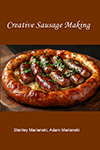Meats and Sausages
Augsburger-Austrian
Augsburger sausage is very popular in Germany and Austria, especially with children.
Augsburg is the third-largest city (after Munich and Nuremberg) in Bavaria, Germany. This old city was founded in 15 BC by the Romans and named after the Roman emperor Augustus. Augsburger sausage was created by the butcher Kotter at meat conference. Austrian Augsburger is finely comminuted sausage, delicately spiced and not smoked. The sausage is is served by pan frying or grilling. For serving the sausages are peeled, halved lengthwise and cut crosswise on the arched side. Then they are dipped in flour and fried on medium heat on both sides until crispy golden brown. Often served with roasted potatoes and cream spinach.
| Materials | Metric | US |
|---|---|---|
| Pork shoulder | 550 g | 1.21 lb |
| Beef* | 100 g | 0.22 lb |
| Back fat, belly or fat trimmings | 200 g | 0.44 lb |
| Iced water | 150 ml | 5 oz fl |
Ingredients per 1000g (1 kg) of materials
| Salt | 15 g | 2.5 tsp |
| Cure #1** | 1.5 g | 1/4 tsp |
| Pepper | 2.0 g | 1 tsp |
| Paprika | 2.0 g | 1 tsp |
| Garlic | 2.0 g | 1 clove |
| Potato starch | 10 g | 1 Tbsp |
Instructions
- Grind all meat and fat through 3 mm (1/8”) plate.
- Blend meat mass, all ingredients and iced water in food processor until a paste is obtained. (If no food processor is available, grind sausage mass again and mix well with all ingredients and water).
- Stuff into 32 mm pork casings making 6” long links weighing around 100 g (3.5 oz).
- Cook in water at 75-78º C (167-172º F) for 45 minutes.
- Cool and refrigerate.
Notes
* You can replace beef with pork rich in connective tissue.
** Traditionally Augsburger sausage is made without sodium nitrite, but in nowadays a small amount of (Cure #1) is occasionally added is to develop a slight pink color.


















